| Article ID | Journal | Published Year | Pages | File Type |
|---|---|---|---|---|
| 1204397 | Journal of Chromatography A | 2011 | 7 Pages |
As one category of the most urgent emerging pollutants, pharmaceuticals have provoked much public and scientific attention due to widespread contamination in aquatic environment. In this study, two active methods by Oasis HLB and MCX and two passive methods by XAD-16 and XAD-16/7 were evaluated for determining the concentrations of 10 pharmaceuticals (carbamazepine, clofibric acid, diclofenac, gemfibrozil, ibuprofen, ketoprofen, naproxen, paracetomol, terbutaline and triclosan) in reclaimed wastewater. Recoveries of the target pharmaceuticals extracted by MCX were higher than HLB except for diclofenac and ketoprofen. For the passive methods, the addition of polar resin XAD-7 improved the recovery compared with the addition of XAD-16 only. The mean recoveries of the target analytes by XAD-16/7 ranged from 22 to 75.8%. The limit of quantification (LOQ) ranged between 25 and 280 ng/L. In addition, by comparing the accuracy and precision of XAD-16/7 method and MCX method, we further demonstrated that the XAD-16/7 method can be satisfactorily used for the analysis of pharmaceuticals in wastewater samples. We applied the method to some wastewater samples from sewage treatment plant (STP) nearby Riverside, CA to track the concentration change of pharmaceuticals in the treatment processes. The result shown that pharmaceuticals were effective reduced in STP mostly by activated sludge.
